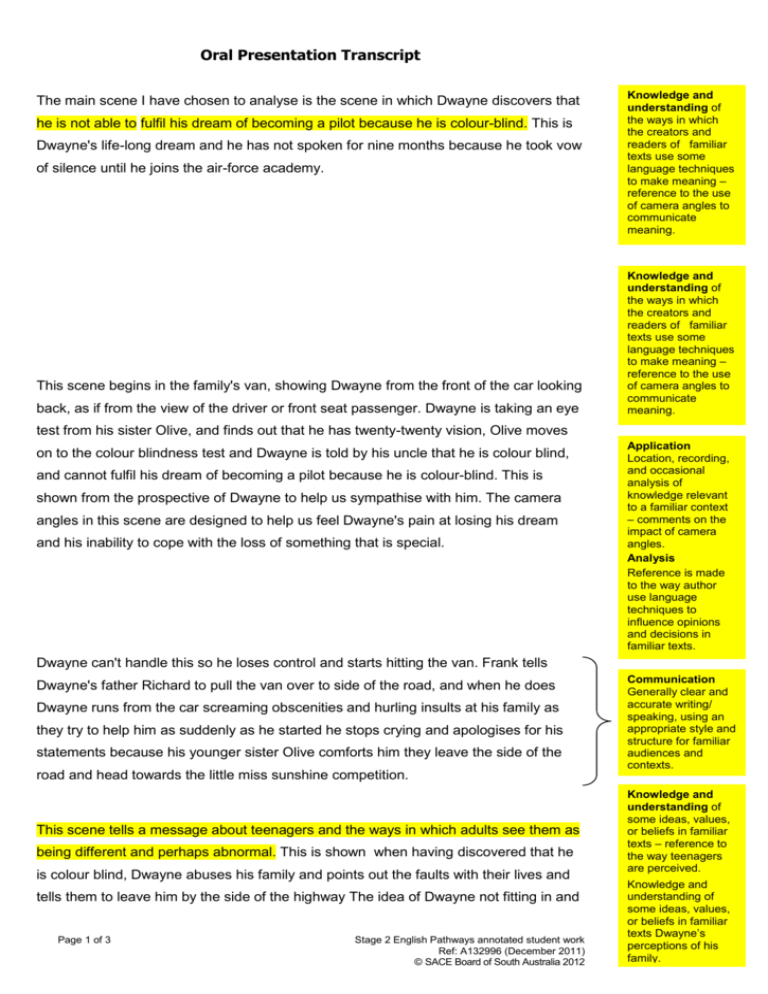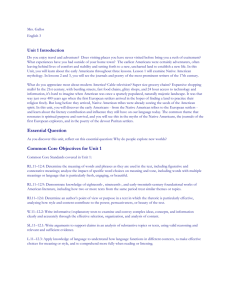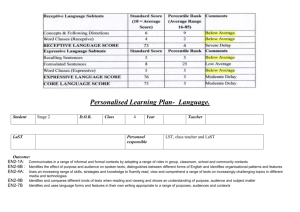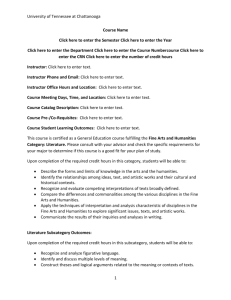oral - SACE
advertisement

Oral Presentation Transcript The main scene I have chosen to analyse is the scene in which Dwayne discovers that he is not able to fulfil his dream of becoming a pilot because he is colour-blind. This is Dwayne's life-long dream and he has not spoken for nine months because he took vow of silence until he joins the air-force academy. This scene begins in the family's van, showing Dwayne from the front of the car looking back, as if from the view of the driver or front seat passenger. Dwayne is taking an eye Knowledge and understanding of the ways in which the creators and readers of familiar texts use some language techniques to make meaning – reference to the use of camera angles to communicate meaning. Knowledge and understanding of the ways in which the creators and readers of familiar texts use some language techniques to make meaning – reference to the use of camera angles to communicate meaning. test from his sister Olive, and finds out that he has twenty-twenty vision, Olive moves on to the colour blindness test and Dwayne is told by his uncle that he is colour blind, and cannot fulfil his dream of becoming a pilot because he is colour-blind. This is shown from the prospective of Dwayne to help us sympathise with him. The camera angles in this scene are designed to help us feel Dwayne's pain at losing his dream and his inability to cope with the loss of something that is special. Application Location, recording, and occasional analysis of knowledge relevant to a familiar context – comments on the impact of camera angles. Analysis Reference is made to the way author use language techniques to influence opinions and decisions in familiar texts. Dwayne can't handle this so he loses control and starts hitting the van. Frank tells Dwayne's father Richard to pull the van over to side of the road, and when he does Dwayne runs from the car screaming obscenities and hurling insults at his family as they try to help him as suddenly as he started he stops crying and apologises for his statements because his younger sister Olive comforts him they leave the side of the road and head towards the little miss sunshine competition. This scene tells a message about teenagers and the ways in which adults see them as being different and perhaps abnormal. This is shown when having discovered that he is colour blind, Dwayne abuses his family and points out the faults with their lives and tells them to leave him by the side of the highway The idea of Dwayne not fitting in and Page 1 of 3 Stage 2 English Pathways annotated student work Ref: A132996 (December 2011) © SACE Board of South Australia 2012 Communication Generally clear and accurate writing/ speaking, using an appropriate style and structure for familiar audiences and contexts. Knowledge and understanding of some ideas, values, or beliefs in familiar texts – reference to the way teenagers are perceived. Knowledge and understanding of some ideas, values, or beliefs in familiar texts Dwayne’s perceptions of his family. hating everyone is continued throughout "Little Miss Sunshine" and is expressed near the start of the movie when Dwayne "tells" his uncle Frank that he hates everyone, Frank asks if this includes his family Dwayne reacts by underlining everyone revealing that he even hates his family, or wants people to believe that he does, because he doesn't wish to end up like his family, in his eyes losers with no ambition or without the ability to reach their ambition. Another theme shown in this scene is teenage anger, the fear that teenagers have that they will turn out like their parents and that they will never amount to anything, Dwayne shows us his fear of never becoming anything of importance, by his vow of silence and his desire to have a high profile military career, namely being a pilot in the air-force. This is generalised statement about teenagers and their fears and inhibitions, making Dwayne a bit of a stereotype, as most teenagers do not have the same fears as Dwayne, though this is a common belief of adults. Analysis Appropriate use of language to convey simple meaning in a narrow range of familiar and unfamiliar contexts. Competent analysis of simple connections between personal experiences, ideas, values, or beliefs and those explored in familiar texts. Additional Comments This presentation is indicative of a C grade. Writing/speaking is generally clear and accurate using simple examples to support ideas being explored in the piece (Communication) Brief references made to some ways in which authors use language techniques, such as camera angles, to influence opinions and decisions in familiar texts. (Analysis) Competent analysis of simple connections between personal experiences, ideas, values, or beliefs and those explored in familiar texts. (Analysis) Knowledge and understanding of some simple ideas and values in familiar texts. (Knowledge and Understanding) Use of specific examples from text indicates ability to locate record, analyse, and synthesise knowledge relevant to context. (Application) Page 2 of 3 Stage 2 English Pathways annotated student work Ref: A132996 (December 2011) © SACE Board of South Australia 2012 Performance Standards for Stage 2 English Pathways A Knowledge and Understanding Analysis Application Communication Detailed knowledge and understanding of the ideas, values, and beliefs in familiar and unfamiliar texts. Detailed analysis of complex connections between personal experiences, ideas, values, and beliefs, and those explored in familiar and unfamiliar texts. Use of a comprehensive range of language skills to interact effectively in different contexts, and to analyse and solve simple and complex problems. Fluent and precise writing and speaking, using an appropriate style and structure for a range of mainly unfamiliar audiences and contexts. Perceptive analysis of a range of ways in which authors use language techniques to influence opinions and decisions in familiar and unfamiliar texts. Location, recording, analysis, and synthesis of knowledge relevant to familiar and unfamiliar contexts. Appropriate use of language to convey mostly complex meaning in a range of familiar and unfamiliar contexts. Knowledge and understanding of the ways in which the creators and readers of familiar and unfamiliar texts use a range of language techniques to make meaning. B Comprehensive knowledge and understanding of the ways in which familiar and unfamiliar texts are composed for a range of purposes and audiences. Perceptive analysis of aspects of familiar and unfamiliar cultural, social, and technical roles of language that support effective interactions in different contexts. Sound knowledge and understanding of some ideas, values, and beliefs in familiar, and some unfamiliar, texts. Analysis of some complex connections between personal experiences, ideas, values, and beliefs, and those explored in familiar, and some unfamiliar, texts. Knowledge and understanding of the ways in which the creators and readers of mainly familiar texts use some language techniques to make meaning. Sound knowledge and understanding of the ways in which mainly familiar texts are composed for some purposes and audiences. C Knowledge and understanding of some ideas, values, or beliefs in familiar texts. Knowledge and understanding of the ways in which the creators and readers of a narrow range of familiar texts use some language techniques to make meaning. Knowledge and understanding of the ways in which familiar texts are composed for familiar purposes and audiences. Page 3 of 3 Well-considered analysis of a range of ways in which authors use language techniques to influence opinions and decisions in familiar, and some unfamiliar, texts. Well-considered analysis of aspects of mainly familiar, and some unfamiliar, cultural, social, or technical roles of language that support effective interactions in different contexts. Competent analysis of simple connections between personal experiences, ideas, values, or beliefs, and those explored in familiar texts. Descriptive analysis of a number of ways in which authors use language techniques to influence opinions and decisions in familiar texts. Competent analysis of some aspects of mainly familiar cultural, social, or technical roles of language that support effective interactions in different contexts. Sophisticated skills in reproducing the structural, conventional, and textual features of text types for a range of familiar and unfamiliar contexts, audiences, and purposes. Use of a sound range of language skills to interact effectively in different contexts, and to solve simple and complex problems. Mostly fluent and precise writing and speaking, using an appropriate style and structure for a range of mostly familiar audiences and contexts. Location, recording, analysis, and occasional synthesis of knowledge relevant to mostly familiar contexts. Appropriate use of language to convey complex and simple meaning in a range of familiar, and some unfamiliar, contexts. Sound skills in reproducing some of the structural, conventional, and textual features of text types for a range of mainly familiar, and some unfamiliar, contexts, audiences, and purposes. Use of competent language skills to interact effectively in different contexts, and to solve routine problems in familiar contexts. Location, recording, and occasional analysis of knowledge relevant to a familiar context. Skills in reproducing some of the structural, conventional, and textual features of some text types for familiar contexts, audiences, and purposes. Generally clear and accurate writing and speaking, using an appropriate style and structure for familiar audiences and contexts. Appropriate use of language to convey simple meaning in a narrow range of familiar and unfamiliar contexts. Stage 2 English Pathways annotated student work Ref: A132996 (December 2011) © SACE Board of South Australia 2012 D Knowledge and Understanding Analysis Application Communication Identification of some simple ideas, values, or beliefs in some familiar texts. Reference to simple connections between uncomplicated personal experiences, ideas, values, or beliefs, and those explored in familiar texts. Use of a restricted range of language skills to interact in familiar contexts, and to solve simple problems. A level of fluency in writing and speaking in personally relevant situations, using an appropriate style and structure for a narrow range of familiar audiences and contexts. Knowledge and understanding of the ways in which the creators and readers of a narrow range of familiar texts use a restricted range of language techniques to make simple or factual meaning. E Reference to some ways in which authors use language techniques to influence opinions and decisions in familiar texts. Knowledge of the ways in which familiar texts are composed for personally relevant purposes and familiar audiences. Reference to some simple aspects of familiar cultural, social, or technical roles of language that support effective interactions in one or more contexts. Identification of a simple idea, value, or belief in a familiar text. Recognition of a simple connection between a straightforward personal experience, idea, value, or belief, and that explored in a highly familiar text. Some knowledge and emerging understanding of the way in which a creator or reader of a highly familiar text uses a language technique to make factual meaning. Some knowledge of the ways in which highly familiar texts are composed for personally relevant purposes and highly familiar audiences. Page 4 of 3 Reference to the way in which an author uses language techniques to influence opinions and decisions in a highly familiar text. Recognition of some simple aspects of highly familiar cultural, social, or technical roles of language that support effective interactions in one or more contexts. Location and recording of factual knowledge relevant to a familiar context. Limited skills in reproducing some of the structural, conventional, or textual features of a text type for a familiar context, audience, or purpose. Use of a restricted range of language skills to interact in highly familiar contexts, and to solve simple problems. Location or recording of factual knowledge relevant to a highly familiar context. Restricted skills in reproducing a limited number of structural, conventional, or textual features of a text type for a highly familiar context, audience, or purpose. Occasionally appropriate use of language to convey simple meaning in familiar contexts. Emerging development of fluency in writing and speaking in personally relevant situations, using an appropriate style and structure for a narrow range of highly familiar audiences and contexts. Occasionally appropriate use of language to convey literal meaning in highly familiar contexts. Stage 2 English Pathways annotated student work Ref: A132996 (December 2011) © SACE Board of South Australia 2012








